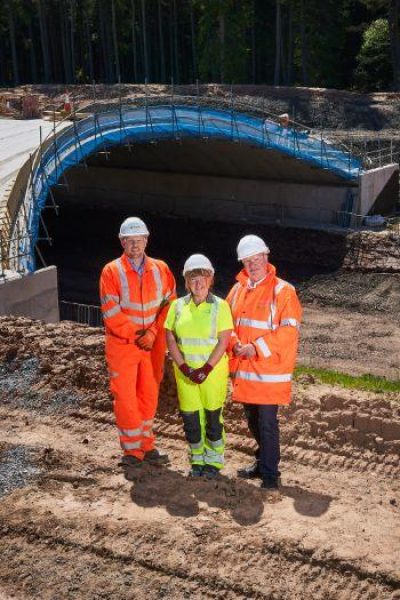Carbon Savings with Destiny Bridge and the New Kingsway

Perth & Kinross Council has placed carbon management at the heart of the Cross Tay Link Road project from its inception - see ICE Carbon Champions Award Article for full details.
The main contractor, BAM UK & Ireland (BAMUK&I), was an early adopter of the Science Based Targets initiative (SBTi) which is considered the highest standard when it comes to verifying an organisation’s carbon targets. On being appointed, an extensive one-year Early Contractor Involvement (ECI) process allowed BAM UK & I to build on the initial work carried out by the Council and SWECO, by putting into place design changes and value engineering that demonstrated how they would achieve a contractual reduction in the project’s carbon footprint bringing, it down by over 35,000 tCO2e, from circa 85,000 tCO2e to just under 50,000 tCO2e.
Now, as the project approaches the halfway mark, project management has predicted savings of circa 35,000 tCO2e (tonnes of carbon dioxide emissions), to be achieved through ongoing, continuous assessment of all areas of the build.
In this article we show where savings have been made across materials, construction and transport - three of the main causes of emissions on a project of this nature - in the build phase covering Jan to Dec 2023.
What key factors were applied between Jan 2023 and Jan 2024 in terms of carbon management.?
At the halfway point, BAMUK&I is on target to achieve this with project savings now predicted to be made as follows:
- Materials –23,761 tCO2e
- Construction – 4,447 tCO2e
- Transport –10,160 tCO2e
- Total – 38,368 tCO2e
There have been various aspects of the project design and build over 2023 which have impacted significantly on the overall carbon reduction. Three examples of which are outlined as follows:
Destiny Bridge - Relocation of bridge piers and asymmetrical backspans
Significant embodied carbon savings were achieved from alterations to the specimen design of the River Tay crossing. The dimensions were reduced from a 155m main span and 92m long back spans to a 150m main span, an 82m western span and an 75m eastern span, thus reducing the concrete and steel required, and bringing about a structural efficiency.
- Carbon saving of 3,079 tCO2e.
Destiny Bridge - Relocation of west abutment
By relocating the west abutment to the east there was scope to provide a piled reinforced-earth approach embankment and to introduce a portal structure through this for continuity of the road.
This arrangement also facilitated the retention of the existing A9 dual carriageway pavement and drainage, reducing the need for materials, transport, and plant, and allowed the team to incorporate existing BT Openreach and Scottish Water services within the portal structure (verge), thereby avoiding the need to carry out permanent diversions.
- Carbon saving - 1,063 tCO2e
Use of flexible pavement with HBM Base on the Link Road
The switch from fully flexible pavement to a flexible composite pavement impacted on carbon cutting efforts by significantly reducing the asphalt road base. Use of Hydraulically Bound Material (HBM) type Cement Bound Granular Mixture (CBGM) has been put into place across the project.
- Carbon saving 1,012 tCO2e
Additional Savings
- Cement replacement ground granulated blast-furnace slag (GGBS) is being used to further reduce embodied carbon; structural concrete mixes contain up to 65% GGBS.
- Drainage design was made more sustainable with more use of grass surface water channels.
- Other carbon saving design changes include refinement of the road geometry and roundabout designs and the change of box culverts to pipes where possible.
MORE READING: See ICE Carbon Champions Award Article >
*****
Building a Sustainable Culture : Why Choose BAM UK & I?
The Royal BAM Group has put sustainability front and centre in its ‘Building a Sustainable Tomorrow’ business strategy which features an enhanced set of carbon reduction targets. As an early adopter of the Science Based Targets initiative - which is considered the highest standard when it comes to verifying an organisation’s carbon targets - our track record on carbon reduction has exceeded all previous targets set since 2008. This is testament to the overall company culture, which strives for continual improvement.
BAMUK&I has set a net zero carbon target for 2026 against its direct scope 1 and 2 emissions, and a further subset of scope 3 emissions over which we have significant influence.
Two of their most recent policy changes evidence this ongoing commitment:
Use of Hydrotreated Vegetable Oil (HVO)
Building on the ‘Diesel Free Sites’ initiative, which aims to eliminate diesel generators from the business, BAMUK&I is now committed to reducing the carbon emissions associated with plant and equipment by replacing traditional high-carbon, liquid fuels (diesel and petrol) with HVO.
The benefits of HVO include carbon reductions of 90% compared to regular diesel, as well as significant reductions in nitrogen oxide (NOx), particulate matter (PM) and carbon monoxide (CO) emissions.
Looking forward, all traditional combustion engines will be phased out in favour of electric power units and hydrogen powered plant.
Low Carbon Concrete (LCC) Enabling Guidance
BAMUK&I has recently developed a new, ‘Low Carbon Concrete (LCC) Enabling Guidance’ which is centred on ready-mix concrete. This is now complete and being used across the business.
As a material that has a significant environmental impact, concrete has been one of the key target materials within BAM’s decarbonisation strategy. The use of LCC – ie maximising the proportion of cement replacement in concrete we use – is not a new concept. However, it is usually driven by client requirements.
This new guidance will help all BAMUK&I personnel to influence every project that has concrete material. By maximising the use of LCC we can ensure consistency across the board, bringing us one step closer to our target reduction goals.

